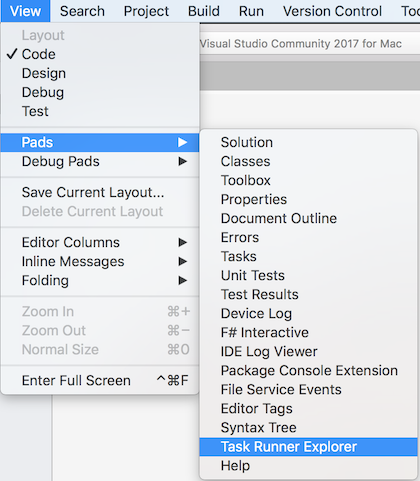
Visual studio for mac properties not working code#
Workspaces is usually able to map the optimized code back to your original source code with the help of source maps. If you're using a modern framework, it probably transforms your source code from a format that's easy for you to maintain into a format that's optimized to run as quickly as possible.

With Workspaces enabled, the CSS changes that you make within DevTools are saved to the source code on your desktop.
You've got localhost:8080 open in Google Chrome, and you're using DevTools to change the site's CSS.  You're running a local web server from the source code directory, so that the site is accessible at localhost:8080. You have the source code for your site on your desktop. Workspaces enable you to save a change that you make in Devtools to a local copy of the same file on your computer. Use DevTools to make basic changes to CSS. Use HTML, CSS, and JavaScript to build a web page. You can view the list of posts on Security and Cryptography here.Prerequisites: Before beginning this tutorial, you should know how to: You can also view the extracted certificate from the browser window. If you still see the same issue then test it a brand new browser session, e.g. NET web project again, the opening page should open without any warning. If you now go back to the Personal store and double-click the localhost certificate then you should see that it’s trusted: There should be a message saying that the import was successful. Click Next and accept all the default values along the way until you reach the end of the wizard. Browse to the certificate you saved just before. Leave the “Local Machine” option untouched in the certificate import wizard, click Next. Next right-click the folder called Trusted Root Certification Authorities and select All Tasks, Import… from the context menu. There should be a popup message saying that the export was successful. Call it “localhost” and save it in a location where you can easily find it. Then you’ll need to provide a name and a location for the exported file. “DER encoded binary X.509” should stay selected, then click Next. Accept the default on the next screen, i.e. Leave the “Do not export the private key” option untouched, click Next. Click Next on the certificate export wizard. Right-click the certificate, then select All Tasks, Export… from the context menu. You’ll see that as a folder in the same snap-in just below “Personal”.
You're running a local web server from the source code directory, so that the site is accessible at localhost:8080. You have the source code for your site on your desktop. Workspaces enable you to save a change that you make in Devtools to a local copy of the same file on your computer. Use DevTools to make basic changes to CSS. Use HTML, CSS, and JavaScript to build a web page. You can view the list of posts on Security and Cryptography here.Prerequisites: Before beginning this tutorial, you should know how to: You can also view the extracted certificate from the browser window. If you still see the same issue then test it a brand new browser session, e.g. NET web project again, the opening page should open without any warning. If you now go back to the Personal store and double-click the localhost certificate then you should see that it’s trusted: There should be a message saying that the import was successful. Click Next and accept all the default values along the way until you reach the end of the wizard. Browse to the certificate you saved just before. Leave the “Local Machine” option untouched in the certificate import wizard, click Next. Next right-click the folder called Trusted Root Certification Authorities and select All Tasks, Import… from the context menu. There should be a popup message saying that the export was successful. Call it “localhost” and save it in a location where you can easily find it. Then you’ll need to provide a name and a location for the exported file. “DER encoded binary X.509” should stay selected, then click Next. Accept the default on the next screen, i.e. Leave the “Do not export the private key” option untouched, click Next. Click Next on the certificate export wizard. Right-click the certificate, then select All Tasks, Export… from the context menu. You’ll see that as a folder in the same snap-in just below “Personal”. 

The message also provides the solution: the certificate must be imported into the trusted root certification authorities folder. If you double-click the certificate you’ll see that it’s not trusted: You can locate the certificate in the Personal folder of the computer-level certificates in the certificates snap-in: The problem is that the certificate that was installed automatically for you by Visual Studio is not trusted. You’ll likely get a message in the browser saying that the localhost address is not trusted, you can continue to the website at your own risk. Locate the Web tab and override the Project Url property with the https address: In the above example it’s Copy that URL and go to the project properties window. The same properties window will also show the HTTPS url for the application. You just select the MVC/Web API project name in the solution and locate the property called “SSL Enabled” in properties window: In other words you’d like to start up the project on a URL similar to The first step is easy. NET MVC or Web API project and you’d like to run it on SSL.








 0 kommentar(er)
0 kommentar(er)
